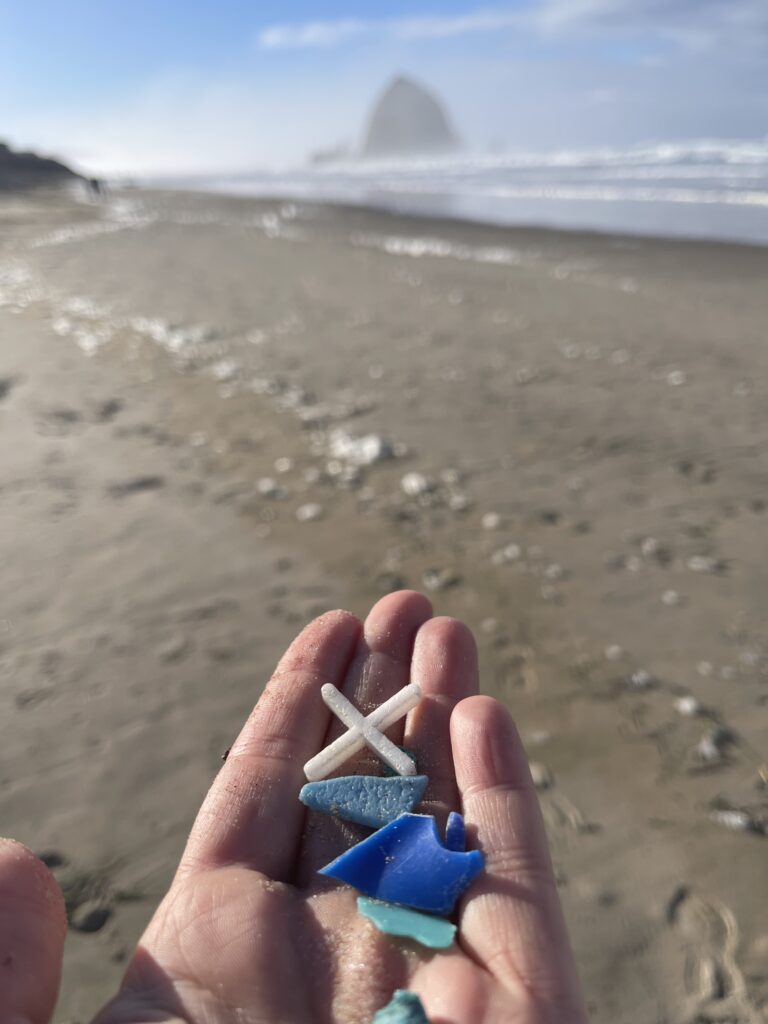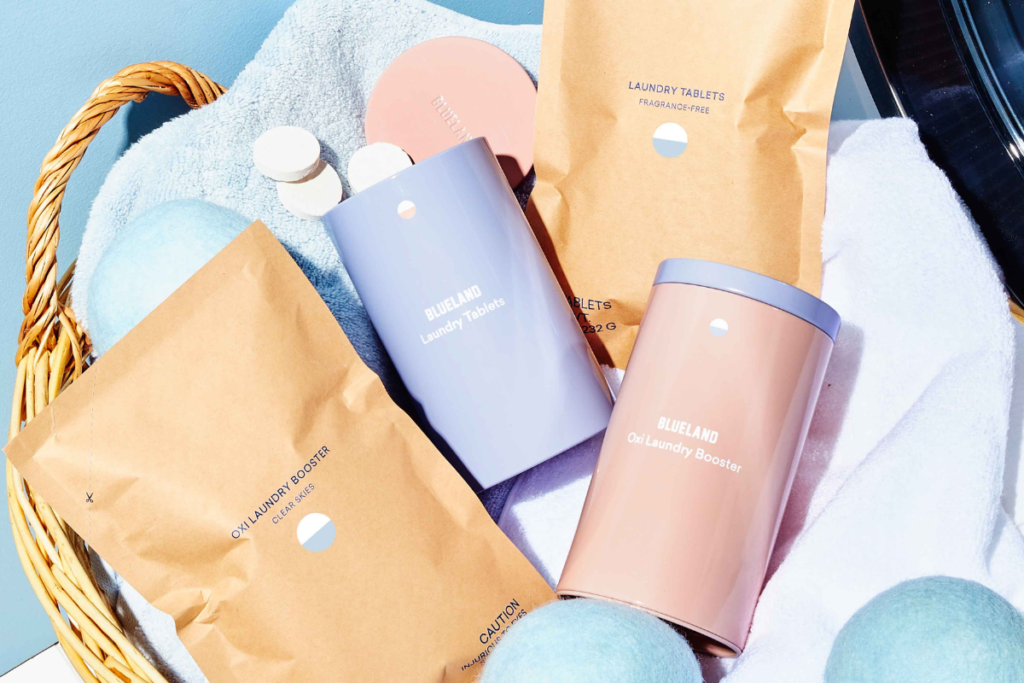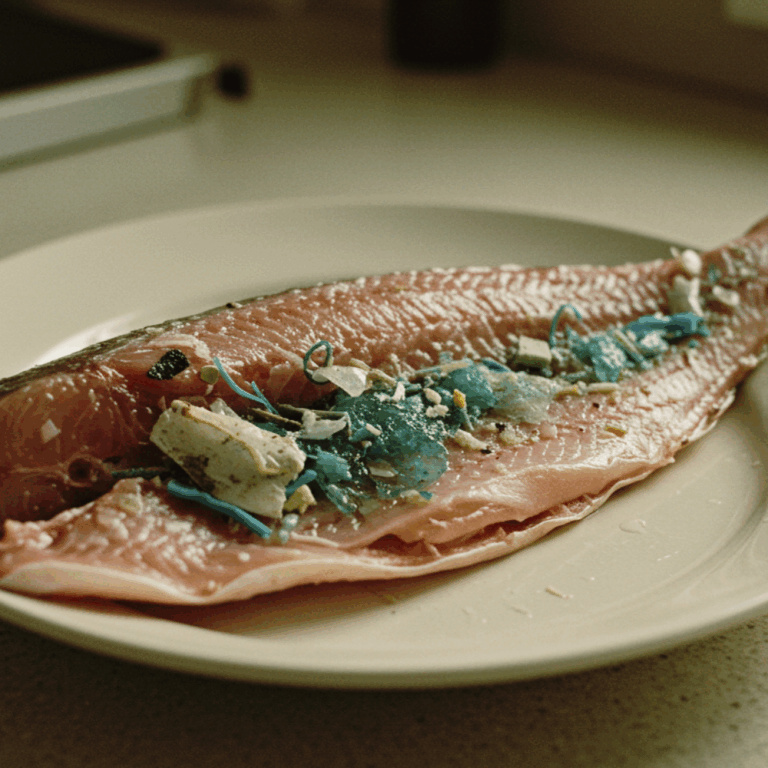
This Post Is Part of a Series on Rethinking Our Relationship with Plastic
When you’re done with this article, explore these next:
What if I told you that every week, you might be unknowingly consuming the equivalent of a credit card’s worth of plastic?
A study from the University of Newcastle, Australia, revealed that the average person might ingest about 5 grams of microplastics each week.
Is this fearmongering, or is there that much of a plastic pollution problem?
When I visited Cannon Beach in Oregon, I expected postcard views, not a reality check. At first it was the usual—waves, sand, that iconic Haystack Rock. But then I started noticing the stuff scattered along the shore: big pieces of plastic, old rope tangled up in seaweed, random bottle caps washed in by the tide.
What really got me though weren’t the obvious things—it was the little bits. Tiny, colorful specks stuck right into the sand. Microplastics. I had to lean down to even see them, but once I did, I couldn’t stop seeing them everywhere.
This wasn’t just some messy beach day. It felt like proof of a much bigger problem happening out at sea. And standing there, I caught myself thinking: How did it come to this? And what can I actually do?
My journey into sustainable living actually began at work. I was part of my company’s employee sustainability leadership team, which opened my eyes to what sustainability truly means on a larger scale. Everything shifted during a meeting when a speaker from the Plastic Soup Foundation gave a talk.
Their presentation on the devastating impact of plastic pollution on our oceans left me deeply concerned and prompted me to look at the sand and see the problem for myself. I was shocked by how little attention this issue was receiving, and it made me realize how urgent it is to address plastic pollution.
What Are Macroplastics and Microplastics?

When I first learned about microplastics, I was shocked to realize just how small they are, less than 5 millimeters. For comparison, that’s slightly shorter than the length of a grain of rice, which typically measures 6–7 millimeters.
These tiny fragments often come from the breakdown of larger plastic items, known as macroplastics, or they are intentionally manufactured that way, like the microbeads in skin care products. Microplastics are everywhere!
Macroplastics are the larger plastic items we encounter daily, such as bottles, bags, straws, food packaging, and other debris.
Over time, exposure to sunlight, waves, and weather causes these larger plastics to break into smaller fragments. What struck me most was realizing how macroplastics and microplastics are connected; what starts as visible pollution on our beaches eventually becomes the invisible pollution that ends up in our water, food, and even our bodies.
Microplastics come from various sources. Beyond the breakdown of macroplastics, they are also found in products we use every day, like exfoliating scrubs with tiny beads or synthetic fibers that shed from clothing during laundry.
So, why should you care?
These plastics don’t just stay in one place. Macroplastics clog up beaches, harm marine life, and disrupt ecosystems, but their journey doesn’t end there.
Once they break into microplastics, they travel through water, air, and soil, often ending up in the food we eat and the water we drink. Marine animals mistake microplastics for food, and when we consume seafood, those microplastics make their way into our bodies.
quote
“The ocean is not a trash can. It’s time to stop treating it like one.” – Emily Penn
Scientists are still figuring out the long-term health effects, but early studies show some serious risks. Microplastics can cause inflammation and may even let toxins build up in our bodies. And it’s not just people who are affected; the environment takes a huge hit too. These tiny plastics sneak into the food chain, pollute our water, and damage ecosystems along the way.
Where Do Microplastics Come From?
One of the most surprising things I’ve learned is just how easily plastic waste makes its way into our waterways and oceans.
It doesn’t take much improper disposal, littering, overflowing storm drains, industrial waste, and even tiny plastic particles washing off synthetic clothes in the laundry, all play a part.
Every piece of plastic that isn’t recycled or properly managed has the potential to end up in our rivers, lakes, and eventually the ocean.
Globally, the scale of plastic production and waste is staggering. According to recent estimates, over 400 million tons of plastic are produced yearly, and only about 9% is recycled. The rest is either incinerated, dumped in landfills, or leaked into the environment.
When I visited Cannon Beach, I saw the effects firsthand; large pieces of macroplastics like bottle caps, fishing nets, and broken plastic littered the shore. These visible items told one part of the story, but what haunted me was the tiny, almost invisible microplastics that are placed in places we can’t see.
Recycling is crucial to tackling this issue. Every time we recycle a plastic bottle or container; we’re keeping it from polluting the environment.
But let’s be real: recycling alone isn’t enough.
Most plastics can only be recycled a limited number of times before they degrade in quality, and not all plastics are recyclable in every community. That’s why cutting back on plastic use is just as important as recycling, it helps reduce the waste in the first place.
Understanding how plastic travels through our environment has changed my perspective on waste management. Properly disposing of trash, choosing recyclable materials, and participating in community clean-ups are small steps that can make a significant difference.
During my time as part of the employee ESG leadership team, we hosted webinars with employees who admitted they weren’t confident in proper recycling practices.
We also partnered with organizations like TerraCycle, which specializes in recycling items that many local waste management programs cannot handle, offering a valuable solution for reducing waste.
How Do Microplastics Enter the Human Body?
Recent studies have revealed the presence of microplastics in various parts of the human body, including lung tissues, maternal and fetal placentas, breast milk, and even blood. Research led by microplastics scientist Heather Leslie, formerly with Vrije Universiteit Amsterdam, detected microplastics in the blood of 17 out of 22 healthy adult volunteers in the Netherlands.
Published in Environment International, this discovery provides clear evidence supporting a long-held scientific belief that these microscopic particles can be absorbed into the bloodstream. They enter our systems through everyday exposure to food, water, and even the air we breathe.
Pathways into the Body
🍤 Microplastics in Food
Microplastics sneak into our food more often than you’d think. They’ve been found in seafood, fruits, veggies, and even packaged snacks. A big reason is that fish and other marine animals mistake plastic for food. Once it’s in them, it travels up the food chain until it reaches us. Food can also get contaminated during farming, processing, or packaging, which makes avoiding it even harder.
💧 Microplastics in Water
Both bottled water and tap water have been shown to contain microplastics. Bottled water often picks up tiny particles from the packaging or bottling process. Tap water can be contaminated when plastic pollution seeps into the environment and enters water systems. Since water is something we drink every single day, this is one of the most significant ways microplastics make their way into our bodies.
🫁 Microplastics in the Air
It’s not just food and water—microplastics are also in the air we breathe. Tiny fibers from clothes, carpets, and other plastic-based materials can float around indoors and outdoors. In cities, where there’s more pollution, the levels are even higher. When we breathe them in, these particles can reach deep into our lungs, which raises concerns about long-term health effects.
Potential Health Risks and Ongoing Research
The health risks of microplastics are still being studied, but researchers suggest they could cause inflammation and other health issues. Some microplastics may also carry harmful chemicals that the body can absorb.
While organizations like the Plastic Soup Foundation play an essential role in raising awareness and reporting on these findings, ongoing scientific research on the long-term effects of microplastics, such as potential links to diseases and disruptions in the body’s natural systems, is being conducted by academic institutions and specialized research groups.
What Can You Do to Reduce Microplastics?
When I first began reflecting on how I could make a difference, I doubted whether my actions would have any real impact. Then, I remembered a story I had heard as a child, the Starfish Story. This familiar parable beautifully illustrates the power of small, meaningful actions.
In the tale, a boy walks along a beach littered with starfish stranded by the receding tide. He begins picking them up one by one, tossing them back into the ocean. A man observes and questions his efforts, pointing out the sheer number of starfish and insisting it’s impossible to make a difference. In response, the boy picks up another starfish, throws it into the water, and says, “It made a difference to that one.”
The story reminds us that even seemingly small efforts can create meaningful change. Simple, intentional actions in our own homes can have a lasting impact. Here are a few ideas to help you get started.
Swap Disposables for Reusables
Choose reusable items like water bottles, shopping bags, and food containers instead of single-use plastic products. It’s a simple change that cuts down on waste. Here are over 23 ideas for swapping plastic items in your home.
Avoid Microbeads and Synthetic Fibers
Microbeads and synthetic fibers are sneaky little troublemakers in many of our personal care products and clothes. These tiny, non-biodegradable plastic particles often hide in exfoliating scrubs, toothpaste, and even body washes. When we wash them down the drain, they slip through water treatment systems and end up in rivers, lakes, and oceans, where they wreak havoc on aquatic life and find their way into the food chain.
The Hidden Presence of Microbeads
Here’s the tricky thing: Microbeads can be hard to spot on ingredient labels. They often hide under names like “polyethylene,” “polypropylene,” “polymethyl methacrylate,” or “nylon.” That’s why it’s smart to check the labels when you’re buying skincare or makeup. Many brands have removed microbeads due to environmental concerns, but it’s still worth being cautious.
The U.S. passed the Microbead-Free Waters Act in 2015, which banned plastic microbeads in rinse-off cosmetics. That was a significant step forward, but here’s the catch: it only applies to cosmetics. Many other products remain uncovered, and not every state has pushed for broader action. So yes, progress is happening, but we’ve still got a long way to go.
Environmental Impact of Synthetic Fibers
Synthetic fibers shed microplastics during washing and take hundreds of years to decompose in the environment. This means that garments made from polyester or nylon that end up in landfills continue to release microplastics into the ecosystem for generations. Opting for natural fibers prevents the release of microplastics and supports a more sustainable life cycle for the clothes you wear.
Alternative Fabrics to Consider
Beyond cotton and wool, explore fabrics made from sustainable sources such as recycled materials, linen, bamboo, hemp, or Tencel. These plant-based and eco-friendly options often have a smaller environmental footprint and reduce the reliance on virgin resources.
Washing Alternatives for Synthetic Fabrics
For those who already own synthetic clothing, washing it less frequently and in cold water can reduce the shedding of microplastics. Additionally, using a Guppyfriend Bag or other microfiber-catching bags can help capture the plastic particles during laundry, preventing them from entering the water system.
Support Sustainable Brands
When you’re out shopping, why not make it a win-win for both you and the planet? Look for brands that put the Earth first. That means choosing products made from sustainable materials or those that keep packaging to a minimum. Here are a few things to keep an eye out for the next time you go shopping:
- Look for Certifications: Check for eco-friendly certifications like Fair Trade, B Corp, or Cradle to Cradle.
- Support Local and Small Businesses: These often have more sustainable practices and a smaller carbon footprint.
- Choose Reusable and Refillable Products: Opt for brands that offer products designed to be reused or refilled.
- Innovative Packaging: Seek out brands using biodegradable, compostable, or recycled packaging.
- Quality Over Quantity: Invest in durable, high-quality products that last longer.
- Second-Hand and Upcycled: Consider brands that sell second-hand or upcycled items.
What Is Being Done to Combat Plastic Pollution?
It’s great to see more action being taken against plastic pollution around the world. New laws, international agreements, and the hard work of dedicated organizations are all helping move things forward, though at times, the pace still feels frustratingly slow.
Legislation and Global Policies
Many countries are tackling plastic pollution by banning or limiting single-use plastics. Common items like plastic straws, cutlery, shopping bags, and foam containers are being phased out in places like the European Union, Canada, and parts of the United States.
For example, the European Union’s Single-Use Plastics Directive prohibits the sale of specific single-use plastic products and introduces Extended Producer Responsibility (EPR) schemes, which require manufacturers to take responsibility for the disposal and recycling of their products.
This approach helps reduce waste and encourages more sustainable production practices. The directive is part of broader efforts in the EU to cut plastic pollution and promote the use of alternative materials. These measures are designed to reduce plastic waste in oceans and landfills while encouraging sustainable alternatives.
In the U.S., states like California and New York have banned plastic bags, while cities like Seattle have eliminated plastic straws and utensils. These efforts not only reduce visible pollution but also help decrease the production of disposable plastics.
International Agreements and Shortcomings
On a global scale, agreements like the United Nations’ Basel Convention aim to regulate the international trade of plastic waste, preventing wealthier nations from offloading their plastic pollution onto less developed countries. In 2022, the United Nations began drafting a legally binding treaty to end plastic pollution by 2040, a landmark effort involving over 170 nations.
To stay informed about these critical international efforts and how they impact communities globally, I encourage you to participate in webinars hosted by organizations like the Plastic Pollution Coalition.
These webinars provide insights into the progress and challenges of international agreements and highlight advocacy opportunities. By joining, you can gain a deeper understanding of how policies are shaping the fight against plastic pollution and discover ways to contribute to the cause. Even if you are just attending to become more educated it makes a difference.
Don’t Miss: Plastic-Free Living: The Truth About Why It Matters Want to learn more about why reducing your plastic use is so important? Check out this guide and start making a difference today. Read more →Leading Brands Tackling Plastic Pollution

One example of companies driving change is Blueland, a brand committed to eliminating single-use plastic through eco-friendly cleaning products. Their mission is simple: reimagine cleaning in a way that reduces waste, using reusable, non-toxic products that are kind to the planet.
But their efforts don’t stop at just selling eco-friendly products, they’re actively fighting against wasteful, single-use plastic packaging at the policy level. Blueland recently took a stand in New York City, advocating for the ban of single-use dishwashing pods.
While these pods might seem convenient, they come with significant environmental drawbacks. Many are encased in plastic that, though it dissolves in water, contributes to microplastic pollution. This type of plastic doesn’t break down easily and can end up in oceans, harming marine life. Blueland hopes that by banning these pods, they can push for more sustainable alternatives, such as dishwashing tablets free of plastic coatings or concentrated liquid formulas that minimize waste.
So, what can we do to support this fight? Keep an eye on brands like Blueland pushing the envelope and take every opportunity to support legislative efforts that hold companies accountable for their packaging practices. You can start here.
Key Organizations Fighting Plastic Pollution
There are some fantastic organizations out there leading the charge against plastic pollution. They’re coming up with creative solutions and spreading the word about why this matters. Here are a few of my favorites:
The Plastic Soup Foundation

Based in the Netherlands, this organization is at the forefront of tackling microplastic pollution. They educate the public about the dangers of microplastics, lobby for legislative change, and partner with industries to phase out harmful practices like the use of microbeads in cosmetics.
One of their standout initiatives is the Beat The Microbead campaign, a global effort to raise awareness about the microplastics sneaking into our cosmetics and personal care products. These tiny particles often hide in things like exfoliants, toothpaste, and makeup, contributing to serious environmental and health issues. But there’s a bright side: their app lets you scan products to check if they contain microplastics, so you can shop with confidence!
Plastic Pollution Coalition
Plastic Pollution Coalition is a global alliance of individuals, businesses, and NGOs committed to eliminating plastic pollution and creating a more sustainable future. Their mission centers on raising awareness of plastic’s environmental, health, and social justice impacts while empowering people to take meaningful action. By advocating for a shift away from single-use plastics, they promote reusable alternatives and work to hold corporations accountable for adopting sustainable practices that prioritize the health of the planet.
One of the Coalition’s key strengths is its educational outreach, including insightful webinars that I highly recommend attending. These sessions cover a wide range of topics, from current legislation aimed at reducing plastic waste to practical advice for transforming everyday habits, such as making more sustainable purchasing decisions at home. They also shed light on how plastic pollution directly impacts human health, offering a holistic understanding of why breaking free from plastic is so crucial. Through collaboration, education, and advocacy, Plastic Pollution Coalition inspires a collective movement toward a plastic-free world.
Ocean Conservancy
Ocean Conservancy is a leading organization dedicated to protecting the world’s oceans through science-based solutions and community engagement. Known for its annual International Coastal Cleanup, it mobilizes millions of volunteers across the globe to remove plastic waste and other debris from shorelines, waterways, and oceans, collecting millions of pounds of trash each year. This hands-on initiative not only restores natural habitats but also raises awareness about the scale of plastic pollution.
Beyond cleanup efforts, Ocean Conservancy plays a critical role in advocating for policies to combat marine plastic pollution at its source. The organization collaborates with governments, businesses, and researchers to develop and implement innovative strategies, such as improving waste management systems, reducing single-use plastics, and promoting a circular economy. Their work also involves empowering local communities and industries to transition toward more sustainable practices. By combining grassroots action with global advocacy, Ocean Conservancy strives to create healthier oceans and a cleaner, plastic-free future.
Key Statistics on Microplastics
Global Contamination: Studies have found that 93% of bottled water and 92% of tap water samples worldwide contain microplastics.
Plastic Production: The world now produces more than 380 million tonnes of plastic annually. If current trends continue, plastic production is expected to double by 2040.
Fossil Fuel Dependency: Plastics, primarily made from fossil fuels like natural gas, crude oil, and coal, have a significant carbon footprint. In 2019 alone, the production and incineration of plastics released 850 million tonnes of greenhouse gases, representing about 2.8% of global emissions, according to the United Nations Environment Programme (UNEP).
Ocean Accumulation: The United Nations Environment Programme (UNEP) reports that 11 million metric tons of plastic waste enter the world’s oceans each year. If current trends continue, UNEP warns, the amount of plastic in the oceans could surpass the weight of fish by 2050. This alarming projection highlights the growing environmental crisis caused by plastic pollution in the marine ecosystem.
FAQs About Microplastics
Microplastics are tiny plastic particles smaller than 5 millimeters, while nanoplastics are even smaller—less than 1 micrometer. They form when larger plastics break down and also come from everyday items like synthetic fabrics, cosmetics, and packaging.
They can enter through contaminated water, soil, and air, as well as through seafood, salt, bottled water, and everyday kitchen habits like microwaving food in plastic or using plastic cutting boards. Once ingested, some particles pass through the gut, while others may travel to organs such as the liver or kidneys.
Research is still emerging, but early studies suggest microplastics may contribute to inflammation, hormone disruption, gut microbiome changes, and reproductive risks. Scientists have already detected microplastics in human blood and placentas, raising concerns about long-term effects.
While it’s impossible to avoid them altogether, you can lower exposure by using glass or stainless steel containers, avoiding microwaving in plastic, switching to wooden cutting boards, filtering drinking water, and choosing foods with minimal or plastic-free packaging.
Final Thoughts on Microplastics: Health Risks, Sources, and How to Reduce Exposure
What started for me as a shocking moment on a beach has turned into a more profound commitment to living with less plastic and speaking up about its impact. Microplastics may be small, but their effects on our health, oceans, and climate are anything but.
The problem can feel overwhelming, but the truth is, our choices add up. Every reusable bag, every product we buy without plastic packaging, every time we support policies or brands that put the planet first—we’re pushing the needle in the right direction.
Like the boy in the starfish story, none of us can solve the entire crisis alone. But together, our everyday actions can spark significant change. The question is: what’s the first step you’ll take today to reduce your plastic footprint?
📚References
- OECD. (2024). Policy scenarios for eliminating plastic pollution by 2040. OECD Publishing. https://www.oecd.org/en/publications/policy-scenarios-for-eliminating-plastic-pollution-by-2040_76400890-en.html
- Our World in Data. (2023). Global plastics production. Retrieved from https://ourworldindata.org/grapher/global-plastics-production
- Santana, J., Domínguez-Rodríguez, A., Pérez-Padilla, Y., Hernández, J., & Hernández-Navarro, T. (2022). Microplastics in the Human Body: Exposure, Detection, and Risk of Carcinogenesis: A State-of-the-Art Review. Environment International, 161, 107131. Retrieved from https://www.sciencedirect.com/science/article/pii/S0160412022001258
- U.S. Congress. (2015). Microbead-Free Waters Act of 2015, H.R. 1321, 114th Cong. Retrieved from https://www.congress.gov/bill/114th-congress/house-bill/1321/text
- United Nations. (2022). Nations agree to end plastic pollution. Retrieved from https://www.un.org/en/climatechange/nations-agree-end-plastic-pollution
- United Nations Environment Programme. (2019). The new plastics economy: Global commitment – 2019 progress report. UNEP. https://www.unep.org/resources/report/new-plastics-economy-global-commitment-2019-progress-report
- United Nations Environment Programme. (2021, October 21). From pollution to solution: A global assessment of marine litter and plastic pollution. UNEP. https://www.unep.org/resources/pollution-solution-global-assessment-marine-litter-and-plastic-pollution
- University of Newcastle, Australia. (2019, June 12). How Much Microplastics Are We Ingesting? Estimation of the Mass of Microplastics Ingested. Retrieved from https://www.newcastle.edu.au/newsroom/featured/plastic-ingestion-by-people-could-be-equating-to-a-credit-card-a-week
- World Health Organization. (2019, August 28). Microplastics in drinking-water: Critical review and assessment of data quality (Technical Report). WHO. https://www.who.int/publications/i/item/9789241516198






